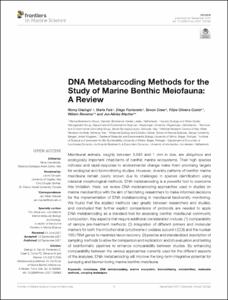DNA Metabarcoding Methods for the Study of Marine Benthic Meiofauna: A Review.

View/
Average rating
votes
Date
2021Author
Gielings, Romy
Fais, Maria
Fontaneto, Diego
Creer, Simon
Costa, Filipe Oliveira
Renema, Willem
Macher, Jan-Niklas
Metadata
Show full item recordAbstract
Meiofaunal animals, roughly between 0.045 and 1 mm in size, are ubiquitous and
ecologically important inhabitants of benthic marine ecosystems. Their high species
richness and rapid response to environmental change make them promising targets
for ecological and biomonitoring studies. However, diversity patterns of benthic marine
meiofauna remain poorly known due to challenges in species identification using
classical morphological methods. DNA metabarcoding is a powerful tool to overcome
this limitation. Here, we review DNA metabarcoding approaches used in studies on
marine meiobenthos with the aim of facilitating researchers to make informed decisions
for the implementation of DNA metabarcoding in meiofaunal biodiversity monitoring.
We found that the applied methods vary greatly between researchers and studies,
and concluded that further explicit comparisons of protocols are needed to apply
DNA metabarcoding as a standard tool for assessing benthic meiofaunal community
com.....
Journal
Frontiers in Marine ScienceVolume
8Issue
Article 730063Page Range
13pp.Document Language
enSustainable Development Goals (SDG)
14.aMaturity Level
MatureDOI Original
10.3389/fmars.2021.730063Citation
Gielings, R., Fais, M,. Fontaneto, D., Creer ,S., Costa, F.O., et al (2021) DNA Metabarcoding Methods for the Study of Marine Benthic Meiofauna: A Review. Frontiers in Marine Science, 8:730063, 13pp. DOI: 10.3389/fmars.2021.730063Collections
The following license files are associated with this item:
 Repository of community practices in Ocean Research, Applications and Data/Information Management
Repository of community practices in Ocean Research, Applications and Data/Information Management
